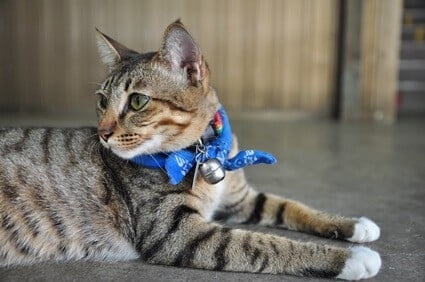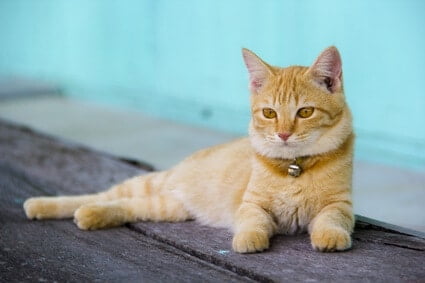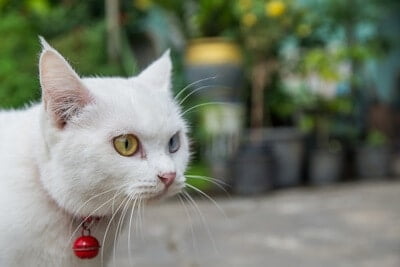To bell or not to bell? This question has perplexed cat owners for years. No legal doctrines surround belled collars and cats, so it is entirely an owner’s choice. There are definite pros and cons to using these accessories.
Belled collars ensure a cat will always be heard. You’ll never lose your cat, no matter how well it is hiding. They also prevent cats from sneaking up on prey. It protects wild birds, but prevents cats from hunting mice. The sound of a belled collar may drive you crazy though, and can be a choking hazard. Only fit a collar if it is safe to do so.
Belled collars are best used on cats that hunt wildlife and are prone to hiding. This way, the cat will not be able to move undetected. If it is causing any avoidable upset, it should be removed.
Should I Fit My Cat with a Belled Collar?
Not all cats wear collars. Usually, cat owners affix such an accessory if their cat wanders outside. This way, it can be identified and returned if lost. Collars also prevent well-meaning strangers from assuming a cat is stray.
In the age of microchipping, collars are a little less essential. A vet can connect a lost cat with its owner with one phone call. These days, a collar is only required if fixed with bells. These announce the presence of a cat, enhancing safety and making cats easier to find.
The choice as to whether to use a belled collar rests with you. You will know better than anybody what is best for your cat. To aid your decision, here are the advantages and disadvantages of affixing belled collars.
Advantages of Belled Cat Collars
There are some clear and undeniable advantages to fixing a cat with a belled collar. This is why these accessories are so popular.
Belled Collars Look Great
Aesthetics should never be at the forefront of your thinking with cats. Yes, felines are graceful and beautiful animals, but they’re still sentient beings with complex emotions. All the same, there is no harm in making your cat look pretty every once in a while.
A belled collar can be a striking accessory for any cat. Black cats, for example, could enjoy a flash of color with a bright collar. Alternatively, they could add two levels of safety when wandering at night. A belled collar with help a cat with dark fur being seen as well as heard.

Some Cats Enjoy the Sound of Bells
If you have a playful cat, a belled collar makes a wearable toy. Some cats, especially younger felines, love the sound of bells. This why small toys contain bells. They will be delighted that their every movement elicits a sound.
If your cat shows no interest in toys, a belled collar is unlikely to appeal. If the cat maintains a kitten-like enthusiasm for play, a belled collar may be a winner. Test if this will be the case by playing with your cat before a collar fitting.
Belled Collars Reveal Your Cat’s Whereabouts
A belled collar means that your cat will always be easy to locate. This could be beneficial to both feline and owner, for a number of reasons.
Nervous or mischievous cats can be prone to hiding. This can be problematic within the home. If you don’t know where your cat is, you risk inadvertently harming it. Cats can emerge from nowhere, getting underfoot and risking being stepped upon.
A belled collar eliminates this risk. It also makes it easier to track down a missing cat. A cat hiding in the garden or under a car can be rapidly located.
Cats can also sneak up and pounce upon humans and other pets. This is a fun game for your cat, but less so for the victim. With the aid of a belled collar, these surprise attacks can be avoided. This also prevents cats from developing unwelcome, dominant habits.
A blind or partially-sighted person would also benefit from a cat wearing a belled collar. A cat leaping into somebody’s lap can be startling if unexpected. The tinkling of bells informs of imminent arrival. This permits somebody to steel themselves accordingly.
Belled Collars Protect Wild Birds
Perhaps the biggest reason to fix a cat with a belled collar is to protect wildlife. Birds, in particular, will benefit from this. As explained by the International Journal of Avian Science, cats are responsible for sharp declines in the animal population.
A cat that hunts birds relies upon moving undetected. Cats achieve this through a range of means. Cats will chirp and coo, imitating birdsong. This disguises the sound of their footfall. The cat then pounces on an unsuspecting bird from behind when within range.
A belled collar will make this impossible for a cat. The birds will hear the cat coming, and quickly scatter before it can get close. This will frustrate the feline but keep the ecosystem flourishing.
Just be aware, cats are crafty. A particularly determined cat may learn how to move in tiny steps, avoiding setting off the bell. In such cases, Biological Conservation recommends a CatBib to save the lives of wild birds.
This could be a viable alternative to a belled collar is protecting birds is your priority. Again, though, this does not reduce hunting instinct. It just prevents a killing blow from being landed.
Disadvantages of Belled Cat Collars
If your cat seems miserable in a collar, there will be a reason. A belled collar could also detrimental to your own quality of life.
Some Cats Hate Belled Collars
Some cats intensely dislike belled collars. Felines prefer to remain silent and undetected while moving. This helps them feel safe. If it appears distressed by a belled collar, it should be removed.
This desire for silent movement is not solely predatory. It is also a defense mechanism. Cats are aware of their stature. They are conscious of their own safety, and instinctively mask their presence from larger predators. Belled collars remove this safety net.
The problem may be as simple as a cat hating collars, period. Most cats tolerate them, but there are always exceptions. Cats are likelier to accept wearing collars if they did so from kittenhood. As felines are averse to change, suddenly applying a collar in middle age may not take.
You could start with a standard collar to help your cat adapt. Science Daily confirms that 75% of cats will tolerate this. From here, you can consider switching a regular collar for a belled counterpart. The noise will become a separate issue, though.
Belled Collars are Noisy
Before fixing a belled collar, remember that they are noisy. You may think this is no big deal. That’s the point of fixing such a collar, after all. After a while though, this noise may start to drive you crazy.
Let’s assume that your cat enjoys the sound of bells. A belled collar means it has access to a noisy toy whenever it wants. All the cat needs to do is move its head. How will you feel if the bells start waking you up at 3 AM? Remember, cats do not keep human hours.
Belled collars can be a headache for light sleepers. Your cat may decide to play or wander in the middle of the night. With every step, you’ll experience noise. This is something to consider if you have children. Cats with belled collars can wake babies at inopportune times.
In addition, not all cats like the sound of bells, or any sound at all. If you have a nervous or jittery cat, the noise will set it on edge. Cats with belled collars may not be able to move without making a sound. This will leave the cat in a permanent state of anxiety, impacting its health.
The noise of belled collars are among the biggest considerations of these accessories. Think about this carefully before committing.
Belled Collars Restrict Hunting
Belled collars stop a cat from hunting. Wild birds will be relieved, as will local ornithologists. Attaching a belled collar to manage hunting is considered, “responsible pet ownership” by the British Ecological Society.
Cats are driven by an instinctive need to engage in hunting behavior, though. By attaching a belled collar, you are making this impossible. Your cat will grow frustrated at what it sees as unfulfilled potential.
With this in mind, carve out more time for play if your cat wears a belled collar. Your cat’s hunting instincts need to be directed somewhere. Use a favorite toy to satisfy this need, multiple times per day. If you fail to do so, the cat will become increasingly annoyed.

This frustration will lead to aggression. This aggression can, in turn, manifest as dominant behavioral problems. These can be tough to coach out of a cat. Do not allow them to set in.
In addition, think about the impact this could have on a cat’s other jobs in the home. A belled collar is a strict no-no if you want your cat to be a mouser. If birds can hear a cat coming, rodents can too. You could soon find your home overrun with unwelcome visitors.
Indoor cats will suffer less from the lack of hunting. They will not be accustomed to stalking birds and will hopefully not encounter many mice. If your cat roams outdoors, a belled collar and stunted hunting instinct must be reviewed carefully.
Belled Collars Can be a Safety Hazard
Collars can be a safety risk for cats. Your cat’s lifestyle must be factored into any decision about whether a belled collar is safe.
Ensure the collar is not too tight. You must be able to fit two fingers under it. This is the sweet spot. Loose enough not to restrict breathing, but not so loose the collar can be slipped off. A loose belled collar is pointless anyway. You cat will learn to move without setting off noise.
Belled collars can get trapped on tree branches and fence posts. If your cat is a wanderer, bear this in mind. It may be some time before you realize your cat is in trouble.
Think about whether your cat comes into conflict with other animals. If your cat is being bulled, a dominant neighborhood feline will always hear it coming. Unfriendly cats could also hook their claws into a collar during conflict.
Ensure your cat does not play with the bells on the collar. This creates an ever-present risk of claws or teeth being trapped within the collar. This will leave your cat in pain, and less receptive to wearing the collar in the future.
Weigh up these pros and cons and decide if a belled collar is right for your cat. Indoor cats may not need such an accessory, unless prone to getting underfoot. Outdoor cats, however, could benefit from enhanced safety. The wild bird population will certainly be relieved.

